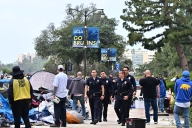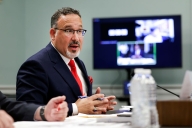You have /5 articles left.
Sign up for a free account or log in.
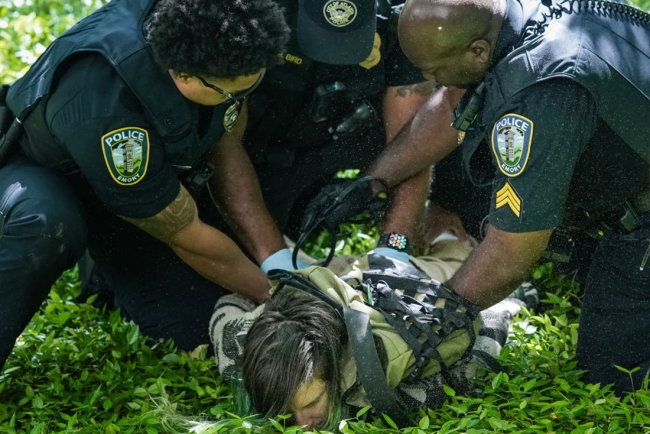
Protesters at Emory University were arrested after being tazed and targeted with rubber bullets. Others on campus reported that police used an irritant gas. Democrats in Georgia condemned the use of “excessive force.”
Photo by ELIJAH NOUVELAGE/AFP via Getty Images
At Emory University in Atlanta on Thursday, police tased pro-Palestinian protesters and targeted them with rubber bullets. A clash between Boston law enforcement and Emerson College students turned so violent that city sanitation workers were spotted cleaning blood from the cobblestone of a campus alleyway. In Austin, dozens of students and faculty rallied to protest what they saw as an excessive use of force Wednesday after officers clad in riot gear—and brandishing shields, batons and some assault rifles—descended on the University of Texas flagship campus and arrested more than 50 protesters.
The increasingly heavy use of force by local and state police officers trying to contain pro-Palestinian demonstrations is raising alarm among student protesters as well as First Amendment advocates, historians and others who have studied the impact of policing on college campuses over the decades.
“The large-scale deployment of armed officers to suppress peaceful protest on college campuses around the country is a shocking development,” the Knight First Amendment Institute said in a statement Thursday. “This response to peaceful protest is an assault on free speech—and it is also deeply reckless.”
The crackdown, which comes after months of protests, has escalated swiftly in recent days as colleges grapple with a fresh wave of unrest after police arrested more than 100 Columbia University students who had pitched tents on a campus lawn. Since the start of the Israel-Hamas war in early October, students have faced suspensions and arrests in connection with the protests. But as the academic year winds down, administrators on some campuses are adopting a harder line, increasingly turning to outside police forces to quell the demonstrations.
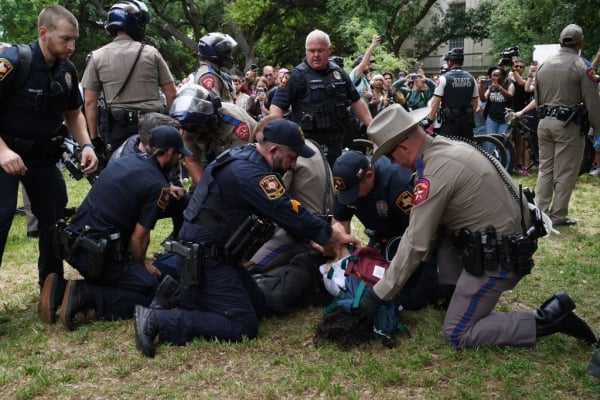
Photo by SUZANNE CORDEIRO/AFP via Getty Images
Some Republicans in Congress, including House Speaker Mike Johnson, have said local and state law enforcement need more help. They urged President Biden to send in the National Guard to protect Jewish students, who have felt threatened by antisemitic rhetoric and violence. Still, sending in the National Guard is a big step that some experts say would represent a dramatic escalation and could lead to violence.
“I don’t think anything good happens with bringing in militarized troops from the outside onto a campus,” said Kevin Kruse, a professor of history at Princeton University. “It doesn’t improve anything. We might get lucky and nothing happens. But we’re setting up conditions for possibly another Kent State.”
Another Day of Crackdowns
Peaceful protests on the Emory University quadrangle Thursday quickly escalated to violent clashes with the Atlanta Police Department and state troopers, who threw tear gas canisters and punctuated the air with the sound of rubber bullets.
Videos posted by local media and public observers show officers tackling protesters, zip-tying their hands behind their backs and loading them into vans. The police department declined to say how many people they arrested, referring all questions to Emory officials, who said “several dozen people” were taken into custody.
A university spokesperson initially denied that the protesters were affiliated with the university, calling them “activists attempting to disrupt our university as our students finish classes and prepare for finals.”
However, students and faculty members have been clearly identified among those arrested. A video provided to Atlanta News First by a Ph.D. student shows Noëlle McAfee, chair of the university philosophy department, being escorted off campus. The spokesperson acknowledged this later in the day, changing the statement to say, “The activists who initially gathered were not recognized as members of our community.”
PT (2) 🚨 HAPPENING NOW AT EMORY: Tasers, Tear Gas, Rubber Bullets—Arrests.
— Shirion Collective (@ShirionOrg) April 25, 2024
⚠️ The footage is pretty intense.
📰 Today’s eruption at Emory University saw police clashing with violent Marxists, whose disruptive protest spiraled into anarchy.
👉👉 Follow @ShirionOrg for… pic.twitter.com/olazmanDbf
A group of Democratic state lawmakers condemned the use of “excessive force” on Emory’s campus, blaming the state’s Republican majority, who they said have created an environment where “state police feel free or perhaps are directed—to respond to normal peaceful protests with violence.”
In Boston, blood was visible in an Emerson College alleyway Thursday morning, evidence of the conflict that had unfurled late the previous night.
Videos and local reporting show students camped along a cobblestone street bracing for impact as they attempted to form a barricade to block police from entering the alley. Standing in rows with their arms locked, they held umbrellas in front of themselves as makeshift shield. But dozens of city police dressed in helmets and reflective jackets approached en masse, holding long sticks. They pulled protesters away from the line and dragged them along the ground.
Multiple students provided GBH News, a public radio station, with photos of injuries they sustained during the sweep. Four police officers also sustained non–life-threatening injuries—three minor and one serious—according to a police spokesman.
Students say protesters were "dragged to the ground" by police as officers cleared a pro-Palestinian encampment at Emerson College. More details: https://t.co/Ql6jYXJq1s pic.twitter.com/gAMWTMfEtL
— WCVB-TV Boston (@WCVB) April 25, 2024
Spread over a block in the heart of downtown Boston, Emerson’s campus makes it difficult for officials to draw lines between where the college ends and the city begins.
Mayor Michelle Wu told WCVB, a local TV station, that she reviewed bodycam footage and supports her officers’ actions. She added that even in a city known for its long history of revolutionary protests starting with the country’s founding fathers, officials must prioritize the safety and well-being of all residents.
“We have to be a city where everybody is safe,” Wu said. “That is my primary mission. I know that events happening around the world are incredibly painful. We have to be a community where everybody can express their views safely.”
The Threat of the National Guard
Although no one had been seriously hurt or killed in the clashes, some observers worry that the tactics police have demonstrated so far, combined with the threat of the National Guard intervening, could be a recipe for disaster.
“These moments call for calm and de-escalation and we’ve got a set of politicians who seem determined to sort of speed run to disaster,” said Kruse, the Princeton historian.
He and others pointed to the 1970 Kent State University shootings, in which Ohio guardsmen killed four people during a student protest of the Vietnam War, as a key reason why deploying military forces now shouldn’t be an option. Shortly after Kent State, city and state police officers shot and killed two people at Jackson State University in Mississippi. They also cited a 1969 incident at North Carolina A&T in which the National Guard raided a college dorm, killing one person and injuring another.
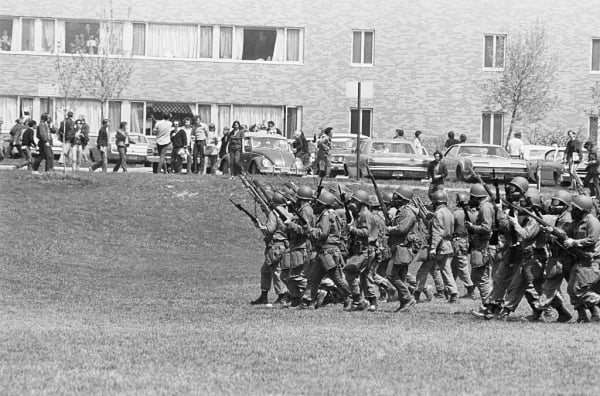
“It seems that we have a broad sense of amnesia of what the National Guard itself is capable of,” said Charles H.F. Davis, an assistant professor of education at the University of Michigan, where he researches structures of domination in U.S. higher education.
Davis said using campus, local and state police to crack down on student protesters is neither new nor surprising, despite the calls for policing reform that arose from the 2020 racial justice protests following the murder of George Floyd.
“It’s a deeply hypocritical set of actions when many institutions have broadly committed to being deliberately anti-racist,” he said. “I think what is interesting about it is the speed with which the escalation has taken place in the face of what are peaceful protests and encampments.”
Kruse sees calls for the National Guard as more of a symbolic message designed to help restore law and order, since campuses and the cities that surround them all have law enforcement agencies of their own.
“But it doesn’t restore order,” he said. “Their campuses are in order right now. What it does is cause chaos.”
When guardsmen have deployed to campuses in the past, it was in response to “genuine disorder,” Kruse said. At Kent State, students smashed store windows and the university’s ROTC building was firebombed before the Ohio governor called in the guard, he said. That’s not the case now.
“As far as I can tell, there’s been no actual threat or no real violence,” he said.
Republican lawmakers, including Johnson and Republican Senators Tom Cotton of Arkansas and Josh Hawley of Missouri, have said the National Guard is needed to protect Jewish students.
After visiting Columbia on Wednesday, Johnson said that if the protests aren’t contained and the threats to Jewish students don’t stop, “there is an appropriate time for the National Guard.”
In a letter requesting that Biden send the National Guard to Morningside Heights, Hawley highlighted the fact that the university canceled in-person classes and that demonstrators had “engaged in shocking displays of antisemitism—assaults on Jewish students, the theft and attempted burning of an Israeli flag, and violent, genocidal rhetoric.”
Either New York Governor Kathy Hochul or President Biden could send the National Guard to campus, though neither has opted to do so yet. White House press secretary Karine Jean-Pierre said Thursday that deploying the guard is something for governors to decide. Hochul said she has no plans to send in the National Guard.
Johnson’s office declined to answer additional questions about what he thinks the National Guard could accomplish that law enforcement can’t. The senators’ offices did not respond to a request for comment. A spokesperson for the National Guard Bureau said that when guard soldiers and airmen are called in, they tend to offer additional resources, such as personnel.
The idea of soldiers descending on a college campus in response to protests might sound far-fetched to some, but in Texas, the National Guard is ready to act if asked. Although the reserve force was not involved in Wednesday’s arrests at UT Austin, the guard was “aware and prepared to respond to the protests,” a Texas MIlitary Department spokesperson said.







